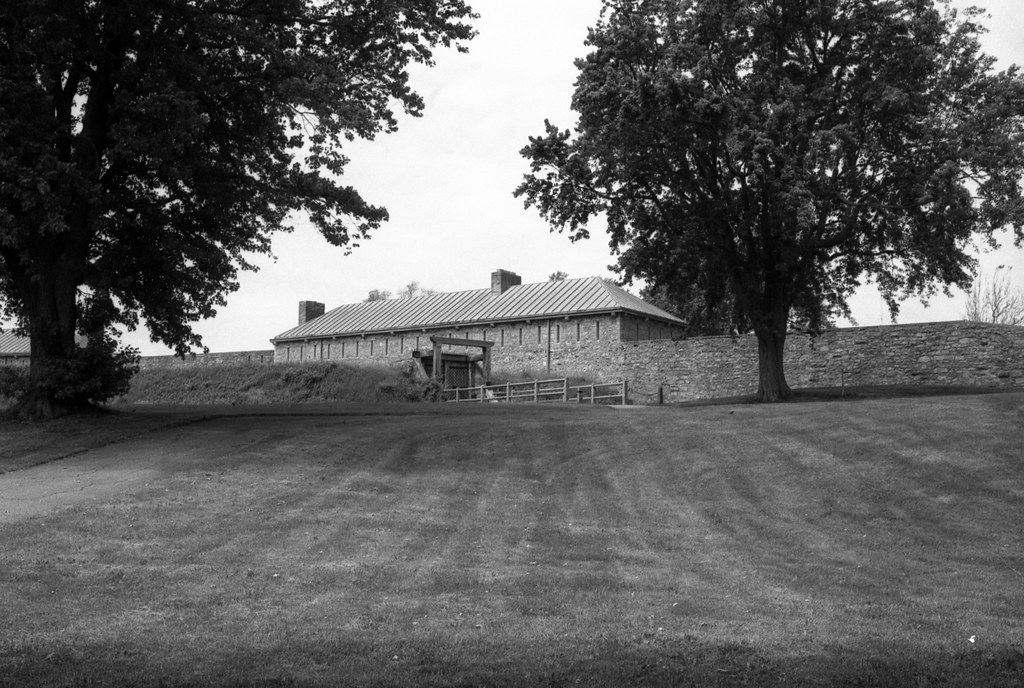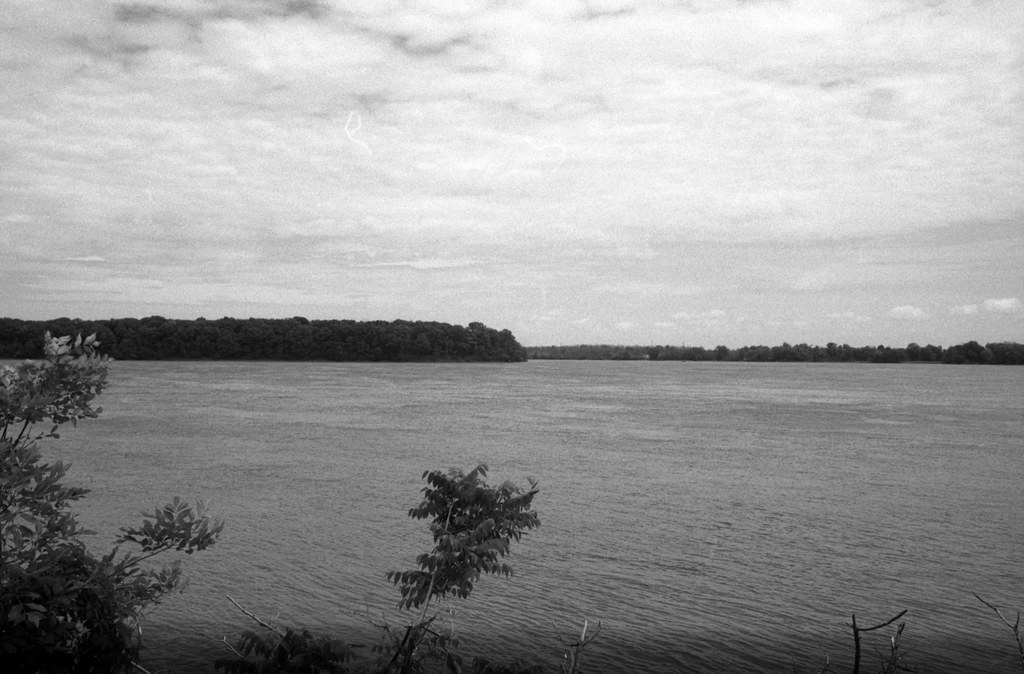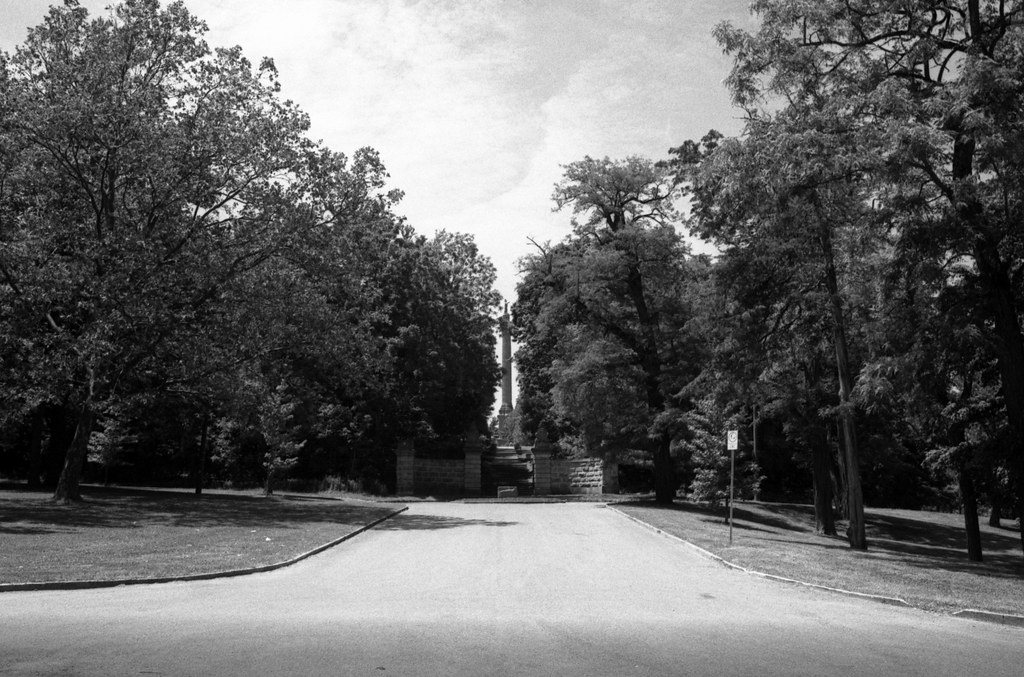What makes this week a bit more interesting is that almost this time last year, Heather and I were on vacation and driving along the Niagara Parkway, a favourite drive for us that is perfectly safe to do even during a global pandemic (but unlike last year, the end is now very much insight). Like last year, I was shooting my Nikon FM loaded with Fomapan 100. But I learned from last year and brought a slightly longer lens and picked a different developer!

Nikon FM – AI-S Nikkor 35mm 1:2.8 (Yellow-12) – Fomapan 100 @ ASA-100 – Adox Rodinal (1+50) 9:00 @ 20C
Long before the arrival of the Europeans, the earliest human settlers in the Niagara Region, those of the Neutral Nation that occupied the land, had carved paths through the ancient forests that once dominated both sides of what we call today the Niagara River. While these paths are long gone, the need for a footpath is obvious with the presence of Niagara Falls that once crashed over the edge of the Niagara Escarpment at Queenston but over the course of thousands of years carved it’s way, forming a deep chasm. Some of the first roads that formally followed the River took place after the American Revolution when a portage road formed from Queenston to Chippawa to aid in the movement of goods along the Niagara River between the lower and upper Great Lakes. With the establishments of Fort George (Niagara-On-the-Lake) and Fort Erie (Fort Erie), a military road would link these two military posts and allow for the movement of troops and supplies for not only the forts but the artillery batteries positioned along the River during the Anglo-American War of 1812 and formed a major front from 1812 to 1814 during that conflict. Following the war, a series of treaties formalised the Anglo-American Border. They began the slow disarmament of that border, starting with the Rush-Bagot Treaty in 1817 and ending with the Treaty of Washington in 1871. As a scenic road, the Niagara Parkway is among the oldest scenic byways in Ontario. Construction started in 1908 and by 1931. What is interesting is that despite being a road, it is not maintained by the Ministry of Transportation or the local government, but rather it is maintained by Niagara Parks. Like a road, it runs from Olde Fort Erie to Fort George, two special locations for me. But it also is a great drive passing through several villages, past some heavily contested spots during the War, including Chippawa and Queenston Heights. What makes it even more interesting is that former Prime Minister Winston Churchill drove the parkway in 1943 describes the parkway as one of the prettiest Sunday afternoon drives in the World. And I agree.

Nikon FM – AI-S Nikkor 35mm 1:2.8 (Yellow-12) – Fomapan 100 @ ASA-100 – Adox Rodinal (1+50) 9:00 @ 20C
Nikon FM – AI-S Nikkor 35mm 1:2.8 (Yellow-12) – Fomapan 100 @ ASA-100 – Adox Rodinal (1+50) 9:00 @ 20C
The great thing about the Niagara Parkway is that the more you drive it, the more you see each time. However, I did want to include the major highlights of the scenic parkway in the order in which Heather and I drove the route. The only variation to this sequence is the featured image taken out of order, but I wanted to show the road itself and was taken shortly after finishing our picnic lunch at one of the many spots along the road. Following that, we take from Fort Erie, showing off the starting point of the parkway and the modern homes that now occupy its banks past the historic settlement of Frenchman’s Creek. While most people associate the Niagara River with the Anglo-American War of 1812, Navy Island is better known for an earlier conflict (the American Revolution) and the Upper Canada Rebellion. Finally, of course, we had to stop at the mid-way point, Niagara Falls, as there was little in the way of tourist traffic. From there, we swung past the Sir Adam Beck Generating Station, which does not offer up a clean angle for photographing the historic hydroelectric generating station. Instead, I opted for a shot of Brock’s Monument on Queenston Heights ending at Niagara-On-the-Lake and my favourite hand-painted sign.

Nikon FM – AI-S Nikkor 35mm 1:2.8 (Yellow-12) – Fomapan 100 @ ASA-100 – Adox Rodinal (1+50) 9:00 @ 20C
Nikon FM – AI-S Nikkor 35mm 1:2.8 (Yellow-12) – Fomapan 100 @ ASA-100 – Adox Rodinal (1+50) 9:00 @ 20C
To keep things simple, as I did drive this as part of the start of my vacation with Heather, I opted for a simple kit going with only my 35mm lens and with the bright hot weather, I added a pale yellow filter. I should have gone with a deeper yellow filter which might have provided a bit more cutting of that blue light, which was plentiful that day. Another thing I probably would have been good in bringing is at least my 105mm to get a bit closer in some of the images that were a bit too distant even with my 35mm lens. I again shot the film at full box speed of ASA-100 and developed it for the first time this year in Rodinal but going with the 1+50 dilution as the 1+25 is far too short and is too contrasty for my tastes. I had forgotten how good Fomapan 100 looks in Rodinal, a great classic look with a touch more grain but good structure and excellent tonal separation and contrast.

Nikon FM – AI-S Nikkor 35mm 1:2.8 (Yellow-12) – Fomapan 100 @ ASA-100 – Adox Rodinal (1+50) 9:00 @ 20C
Nikon FM – AI-S Nikkor 35mm 1:2.8 (Yellow-12) – Fomapan 100 @ ASA-100 – Adox Rodinal (1+50) 9:00 @ 20C
Next week we’re taking a bit of a trip back through time with an early morning visit to the Westfield Heritage Village.